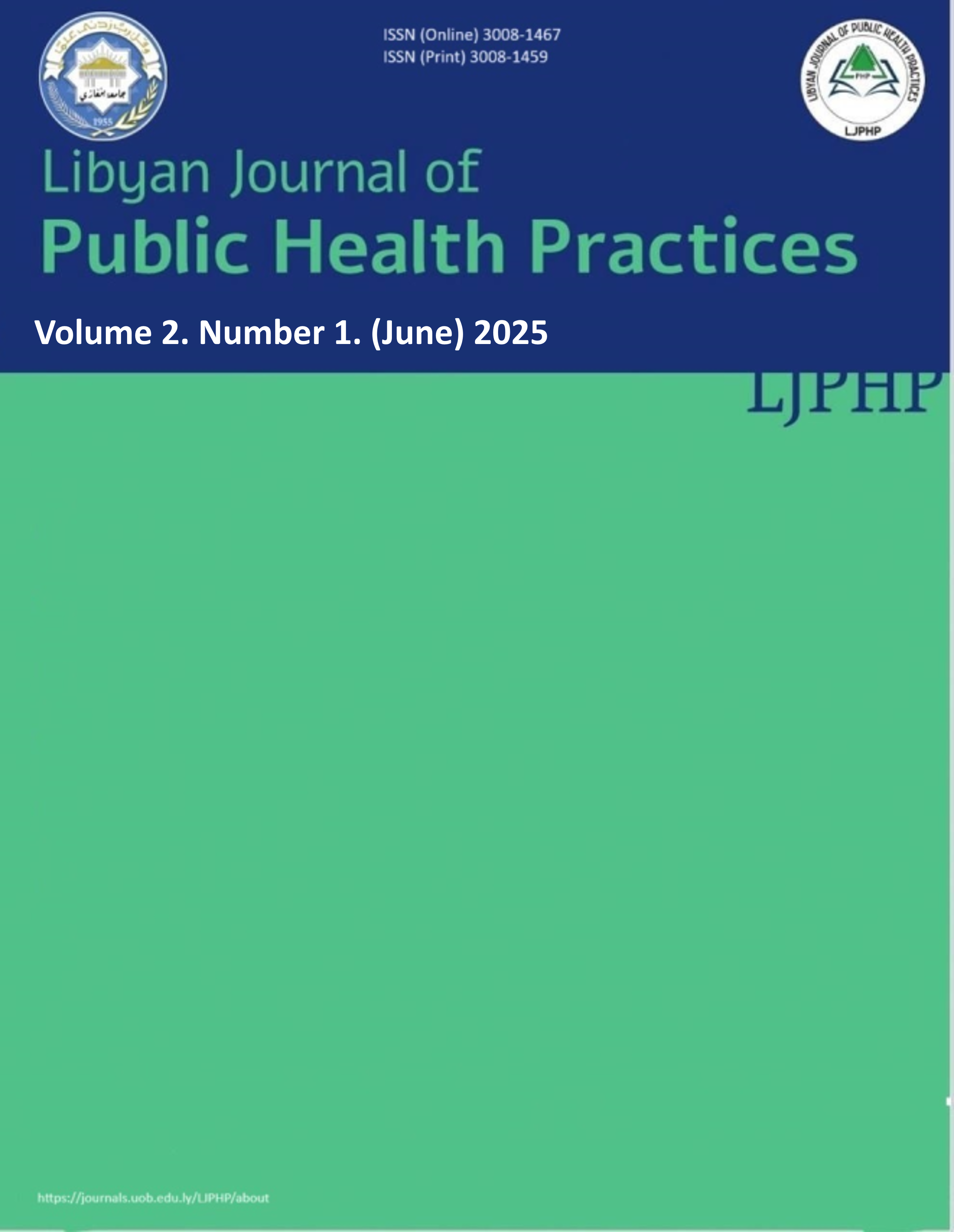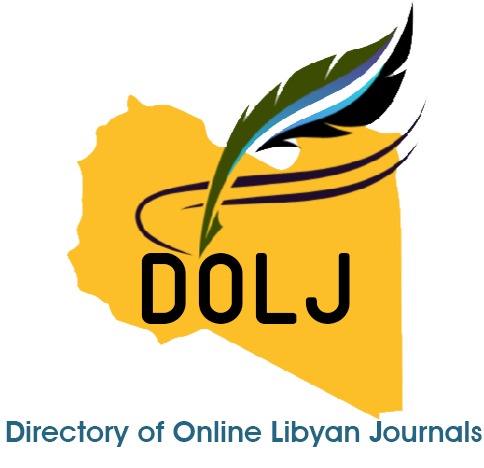Predictors of Severity in Autism Spectrum Disorders among Libyan Children: Cross-sectional analysis in Almarj
DOI:
https://doi.org/10.37376/ljphp.v2i1.7347Keywords:
Libya, Severity, Predicators, Autism, ASDAbstract
Today, autism spectrum disorders (ASD) are among the most prevalent neurodevelopmental illnesses. Their varied degrees of severity influence and determine the necessary support and intervention. Risk elements of severity include the child's gender, parental age, and parental educational levels. In Libya, such factors are under-examined. This study aimed to identify predictors of autism severity in Libyan children diagnosed with ASD attending rehabilitation centers in Almarj. It adhered to ethical considerations by submitting a formal application to the centers and obtaining consent from participants. A cross-sectional study included 119 children diagnosed by the Childhood Autism Rating Scale(C.A.R.S) .Demographic information, including child gender, age, educational level, parental age, and education, was gathered through parent interviews. The 2 to 12 year-old sample comprised 73% males and 27% females, with a mean of 7.3 years. About 73.1% had their diagnosis after two years of age. The school achievement of the majority of them affected by Autism, as about 69% (N=82) were not at the appropriate school level for their age. Paternal age over 40 years was notably linked to affect autism severity (OR = 0.198, 95% CI: 0.059–0.661, p = 0.008). Child gender, maternal age, and parental education exhibited no significant connection. Although all registered children with ASD was included, the small sample size limit the ability to generalize the results. Early screening might help families with older fathers to get benefit from advantages of early Autism diagnosis in Libya. This study helps to optimize clinical management and improve regional outcomes for children with ASD
References
ASD
American Psychiatric Association. Diagnostic and Statistical Manual of Mental Disorders. 5th ed. American Psychiatric Publishing; 2013.
Gillberg C. Autism spectrum disorders. In: Gillberg C, Harrington R, Steinhausen HC, eds. A Clinician’s Handbook of Child and Adolescent Psychiatry. Cambridge University Press. 2006;447-488.
Fombonne E. Epidemiology of autistic disorder and other pervasive developmental disorders. J Clin Psychiatry. 2005;66(suppl 10):3-8.
Elsabbagh M, Divan G, Koh YJ, et al. Global prevalence of autism and other pervasive developmental disorders. Autism Res. 2012;5(3):160-179. doi:10.1002/aur.239
Zeidan J, Fombonne E, Scorah J, et al. Global prevalence of autism: A systematic review update. Autism Res. 2022;15(5):778-790. doi:10.1002/aur.2696
Shminan AS, Sharif S, Choi LJ, Fauzan N. Insight of autism screening, intervention and its correlation. 2019; Accessed June 12, 2025. https://ir.unimas.my/id/eprint/26285/
Hultman CM, Sandin S, Levine SZ, et al. Advancing paternal age and risk of autism: New evidence from a population-based study and a meta-analysis of epidemiological studies. Mol Psychiatry. 2011;16(12):1203-1212. doi:10.1038/mp.2010.121
Kong A, Frigge ML, Masson G, et al. Rate of de novo mutations and the importance of father's age to disease risk. Nature. 2012;488(7412):471-475. doi:10.1038/nature11396
Lai MC, Lombardo MV, Baron-Cohen S. Autism. Lancet. 2014;383(9920):896-910. doi:10.1016/S0140-6736(13)61539-1
Sandin S, Lichtenstein P, Kuja-Halkola R, et al. The familial risk of autism. JAMA. 2014;311(17):1770-1777. doi:10.1001/jama.2014.4144
Xie S, Karlsson H, Dalman C, et al. Family history of mental and neurological disorders and risk of autism. Mol Psychiatry. 2019;24(6):1-11.
Sandin S, Schendel D, Magnusson P, et al. Autism risk associated with parental age and with increasing difference in age between the parents. Mol Psychiatry. 2016;21(5):693-700. doi:10.1038/mp.2015.70
Mamidala MP, Polinedi A, PTV PK, et al. Prenatal, perinatal and neonatal risk factors of Autism Spectrum Disorder: a comprehensive epidemiological assessment from India. Res Dev Disabil. 2013;34(9):3004-3013. doi:10.1016/j.ridd.2013.06.019
Schopler E, Andrews CE, Strupp K. Do autistic children come from upper-middle-class parents? J Autism Dev Disord. 1979;9(2):139-152. doi:10.1007/BF01531530
Lobascher M, Kingerlee P, Gubbay S. Childhood autism: an investigation of the etiological factors in twenty-five cases. Br J Psychiatry. 1970;117(540):525-529. doi:10.1192/bjp.117.540.525
Zwaigenbaum L, Bauman ML, Choueiri R, et al. Early identification and interventions for autism spectrum disorder: Executive summary. Pediatrics. 2015;136(suppl 1):S1-S9.
Kolevzon A, Gross R, Reichenberg A. Prenatal and perinatal risk factors for autism: a review and integration of findings. Arch Pediatr Adolesc Med. 2007;161(4):326-333. doi:10.1001/archpedi.161.4.326
Lai MC, Baron-Cohen S, Buxbaum J. Understanding autism in the light of sex/gender. Mol Autism. 2015;6. doi:10.1186/s13229-015-0021-4.
Lawson, L.P., Joshi, R.,
Barbaro, J. et al. Gender
Differences DuringToddlerhood in AutismSpectrum Disorder: A Prospective Community-Based
Longitudinal Follow-Up Study.
J Autism Dev Disord. 2018;48,
–
https://doi.org/10.1007/s10803-
-3516-y
Dehesh T, Mosleh-Shirazi MA, Jafari S, et al. Assessment of the effects of parental age on the development of autism in children: a systematic review and a meta-analysis. BMC Psychol. 2024;12(1):685. doi:10.1186/s40359-024-02184-9
Downloads
Published
How to Cite
Issue
Section
License
Copyright (c) 2025 Libyan Journal of Public Health Practices

This work is licensed under a Creative Commons Attribution-NonCommercial-NoDerivatives 4.0 International License.












